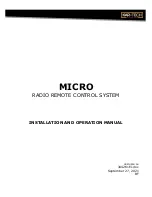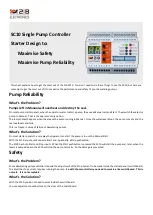
CC484/CC486/CC488 |
Operators Manual | 3.
Codepad Indicators
EN
| 7
Bosch Security Systems | 3/04 | SUB-MA48XO-3318
3.8 FAULT
Indicator
The FAULT indicator displays that the
system detected a system fault. See
Section 9. Fault Analysis Mode
for
additional information on system faults.
Every time a new system fault is
detected (such as, FAULT indicator
flashing), the codepad begins to beep
once every minute. Pressing the [#]
button once cancels the once a minute
beep and acknowledges the fault (such
as, FAULT indicator on steady).
Table 6:
FAULT Indicator
Indicator
Definition
On
There is a system fault that
needs to be rectified.
Off
The system is normal, there are
no faults.
Flashing
There is a system fault that
needs to be acknowledged.
3.9 Audible
Indications
Table 7
defines the audible indicators given out by
the codepad buzzer.
Table 7:
Audible Indicators
Audible
Indicator
Definition
One short beep
A button was pressed on the
codepad, or exit time ended
when armed in STAY Mode 1
or STAY Mode 2.
Two short beeps
The system accepted your
code.
Three short
beeps
The requested function was
executed.
One long beep
Indicates the end of exit time
when armed in AWAY Mode, or
the requested operation was
denied or aborted.
One beep every
second
Walk Test Mode is currently
active or a warning before
automatic arming takes place.
One short beep
every minute
There is a system fault waiting
to be acknowledged.
3.10 Arming the System
There are several ways to arm the system
depending on whether you are:
•
Leaving the premises and require all active
zones to be in a ready state for an intruder.
•
Remaining in the premises and only require
part of the system to be in a ready state for an
intruder.
If a zone is not sealed at the end of exit time, the
zone is automatically isolated and constantly
displayed on the remote codepad. The zone
becomes an active part of the system when the
zone is restored.
For example, if a window is left open after exit
time expired, the window is not an active part of
the system until the window is closed. Opening
the window after exit time expired causes an
alarm condition.
Table 8
defines the different methods for arming
the system.
Table 8:
Arming Methods
Mode
Arming Method
AWAY Mode
Arms the entire system. See
Section
3.10.2 Arming in AWAY Mode
.
STAY Mode 1
Arms all zones except those
programmed to be automatically
isolated by the installer. See
Section
3.10.3 Arming in STAY Mode 1
.
STAY Mode 2
Arms all zones except those
programmed to be automatically
isolated by the Master Code holder.
See
Section 3.10.4 Arming in STAY
Mode 2
.
3.10.1 Forced
Arming
The feature of arming the system when a zone is
not sealed is known as forced arming. If the
system does not arm and a long beep is heard,
forced arming is not permitted. If this is the case,
you must ensure that all zones are sealed or
manually isolated before you can arm the system.
See
Section 8. Isolating Zones
.
3.10.2
Arming in AWAY Mode
When you leave your premises and require all
zones to be in a ready state to detect intrusion,
arm the system in AWAY Mode.
There are two different methods for arming the
system in AWAY Mode. Method one is standard
and always operates. Method two is optional and
can be disabled by your installer if you do not
want to use single button arming.








































